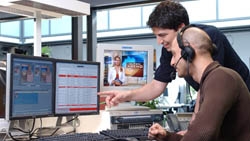Pebble Beach discusses automation trends

A Pebble Beach automation system in use at AZ Media in Hamburg, Germany.
This is the first of a regular series where Automation Technology Update visits with an automation vendor. Each vendor will be asked a series of questions to get insight into how each sees the industry developing.
Automation has come a long way from the tape cart machines that played out during commercial breaks and there are constant advances in the systems.
This week we visited with Peter Hajittofi, managing director of Pebble Beach Systems. Based in the UK, Pebble Beach was founded in 2000 as a software company specializing in broadcast automation.
ATU: What is single most important reason that a broadcaster should use automation?
Peter Hajittofi: There isn’t a single reason — it depends on the broadcaster, and the problems they are trying to solve. Some are looking for less on-air mishaps (lost commercials), others want an improved presentation style. Some want to run more channels from the same facility while others want to maximize advertising revenues by selling closer to the wire.
ATU: What areas should a broadcaster automate first?
- On-air commercial playout
- On-air program playout
- Ingest
- Archive
- Digital asset management
- Facility management
- Newsrooms
PH: The first area should be commercial playout, that’s the revenue stream. The second area is program playout. High-quality presentations help to keep viewers watching the commercials. About half of our systems involve links to newsrooms systems.
We see facility management as a separate issue. The customer should choose the best of breed and interface the different applications. That demands standard interfaces to and from the automation.
ATU: Does this mean the broadcaster can approach automation with a building-block approach? If so, doesn’t this mean that the broadcast is then forever locked into one vendor?
PH: Yes we use building blocks. Our products are modular, but we do not expect the customer to buy every element from a single vendor, they should choose best of breed.
ATU: What are some of the regional differences in how automation is implemented?
Peter Hajittofi: We see differences in style rather than regional differences. Compare a prime channel with many live events versus a basic playlist. That said we do see areas such as the Eastern Block tolerating a lower service level if it means the capital cost is lower. They buy n+1 redundancy, rather than the full mirroring seen in Western Europe.
As to languages, some customers are happy to work with an English user interface. Others demand their local language. We have supplied Arabic GUIs with right-to-left text.
ATU: What immediate benefits would a broadcaster see with the implementation of automation?
PH: Fewer on-air mishaps, an improved presentation style and reduced costs. They can run more channels with the same staff, and the logs are more accurate.
ATU: There has been much discussion about moving control of playout from the master control area back into the traffic department, where programs and commercials are initially booked. What challenges does this place on an automation vendor? What differences does this make in the operation of the control room?
PH: We are talking to several customers about this right now. We have an existing API to remotely manipulate the playlist. It’s not so much the technology. Customers are nervous about letting sales and traffic run the channels. At the moment master control is responsible for the output. If you take that away, you are potentially losing quality control. So it’s more an issue of roles and responsibilities.
ATU: What sort of interface is needed with traffic and sales?
PH: With XML it is easy to set up standard playlists, logs, purge lists and dub lists, but a commonly agreed format from a body such as SMPTE would be a good idea.
ATU: What key features should a customer look for in an automation system?
PH: Reliability first. In a fast-changing business environment, flexibility and expandability are important. You may want to add new channels next year. And we mustn’t forget the operator, an intuitive user interface is very important. Many stations run with unskilled staff with no background in video operations. I have been at customers' facilities where the master control staff didn’t even know what timecode was.
ATU: How can a customer estimate the ROI for an automation system?
PH: They know their starting costs. They need to look at the investment versus staff savings. They may also be able to command more for airtime if they are selling closer to air time. This also can be estimated by the sales department.
ATU: What do you think will be the next big idea in automation?
PH: Managing interactive television playout. We are seeing demand for systems such as SMS voting influencing the playlist. It’s a good potential revenue earner outside classic interstitial advertising. Beyond that we see more automation of asset libraries and archives.
To learn more about Pebble Beach, visit www.pebble.tv.
Get the TV Tech Newsletter
The professional video industry's #1 source for news, trends and product and tech information. Sign up below.
